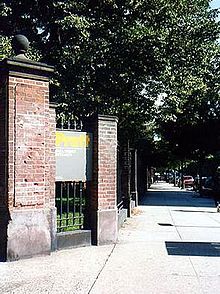
A | B | C | D | E | F | G | H | CH | I | J | K | L | M | N | O | P | Q | R | S | T | U | V | W | X | Y | Z | 0 | 1 | 2 | 3 | 4 | 5 | 6 | 7 | 8 | 9
 | |
| Motto | Be true to your work, and your work will be true to you. |
|---|---|
| Type | Private university |
| Established | 1887 |
| Founder | Charles Pratt |
| Endowment | $224.5 million (2020)[1] |
| President | Frances Bronet[2] |
Academic staff | 163 (full-time) 992 (part-time)[3] |
| Students | 5,137 (Fall 2021)[4] |
| Undergraduates | 3,675 (Fall 2021)[4] |
| Postgraduates | 1,462 (Fall 2021)[4] |
| Location | , , 11205 , United States 40°41′28″N 73°57′50″W / 40.691111°N 73.963889°W |
| Campus | Large City, Urban, 25 acres (10.1 ha) |
| Colors | Black, White and Yellow[5] |
| Nickname | Cannoneers |
Sporting affiliations | ACAA (NCAA Division III) HVAC (USCAA) |
| Mascot | Charlie the Cannoneer [6] |
| Website | pratt.edu |
Pratt Institute is a private university with its main campus in Brooklyn, New York. It has a satellite campus in Manhattan and an extension campus in Utica, New York at the Munson-Williams-Proctor Arts Institute.[7] The school was founded in 1887 with programs primarily in engineering, architecture, and fine arts.[8] Comprising six schools, the institute is primarily known for its programs in architecture, graphic design, interior design, and industrial design.[9]
History
Inception
This section needs additional citations for verification. (May 2018) |

Pratt Institute was founded in 1887 by American industrialist Charles Pratt, who was a successful businessman and oil tycoon and was one of the wealthiest men in the history of Brooklyn. Pratt was an early pioneer of the oil industry in the United States and was the founder of Astral Oil Works based in the Greenpoint section of Brooklyn which was a leader in replacing whale oil with petroleum or natural oil. In 1867, Pratt established Charles Pratt and Company. In 1874, Pratt's companies amalgamated with John D. Rockefeller's companies. They became part of the Standard Oil trust where Pratt continued his active involvement on the board and the running of it.
Pratt, an advocate of education, wanted to provide working men and women the opportunity to better their lives through education. Even though Pratt never had the chance to go to college himself, he wanted to create an affordable college accessible to the working class. In 1884, Pratt began purchasing parcels of land in his affluent hometown of Clinton Hill to open a school. The school would end up being built only two blocks from Charles Pratt's residence on Clinton Avenue.
From his fortunes with Astral Oil and Charles Pratt and Company, in 1886 he endowed and founded Pratt Institute. In May 1887, the New York State Legislature granted Charles Pratt a charter to open the school; on October 17, 1887, the institute opened to 12 students in the Main Hall. Tuition was $4 per class per term (approximately equivalent to $135.6 in 2023).[10] The college was one of the first in the country open to all people, regardless of class, color, and gender. In the early years, the institute's mission was to offer education to those who never had it offered to them before. Pratt sought to teach people skills that would allow them to be successful and work their way up the economic ladder. Specifically, many programs were tailored to the growing need to train industrial workers in the changing economy with training in design and engineering. Early programs sought to teach students a variety of subjects such as architectural engineering, mechanics, dressmaking, and furniture making. Graduates of the school were taught to become engineers, mechanics, and technicians. Drawing, whether freehand, mechanical, or architectural, thought of as being a universal language, united such diverse programs and thus all programs in the school had a strong foundation in drawing. In addition, the curriculum at the institute was to be complemented by a large Liberal Arts curriculum. Students studied subjects such as history, mathematics, physics, and literature to better understand the world in which they will be working, which is still used in Pratt's curriculum.[10]
Early years
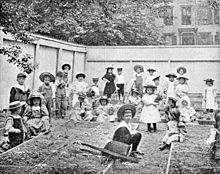
Enrollment grew steadily from its inception. Six months after opening, the school had an enrollment of nearly 600 students. By the first anniversary of the school, there were 1,000 students in attendance. In five years the school had nearly 4,000 students.[10] In 1888, Scientific American said of the school that "it is undoubtedly the most important enterprise of its kind in this country, if not in the world".[10] Andrew Carnegie visited Pratt for inspiration and used the school as a model in developing Carnegie Technical Schools, now Carnegie Mellon University.[11] At the first Founder's Day celebration in 1888, Charles Pratt addressed what would become the school's motto: "be true to your work and your work will be true to you"—meaning that students should educate and develop themselves diligently and go out into the world working hard, giving all of themselves.
As public interest grew in the school and demand increased, the school began adding new programs including the Pratt High School, Library School, Music Department, and Department of Commerce.[12] Because of the overwhelming popularity of the Department of Commerce, the department broke off from the main institute and formed its own school, under the guidance of Norman P. Heffley, personal secretary to Charles Pratt.[13][14] The Heffley School of Commerce, the former Pratt Department of Commerce, originally having shared facilities with Pratt, evolved into Brooklyn Law School.[15]
In 1891, the institute's founder and first president, Charles Pratt, died and his eldest son, Charles Millard Pratt, became president of the school. In 1893, Charles Pratt's other son, Frederic B. Pratt, was elected President of Pratt Institute taking over from his elder brother. Because Charles Pratt Snr. died so soon after the college was founded, Frederic Pratt is ascribed with guiding the college through its early decades.[16] Under the direction of Pratt's sons, the institute thrived both financially and critically with many new construction projects and courses. By 1892, the number of students enrolled was 3,900. In 1897 the most popular major was domestic arts.[17]
In 1896, the school opened its monumental Victorian-Renaissance Revival library with interiors designed by the Tiffany Decorating and Glass Company and sprawling gardens outside the library. The library was open to students and the general public as well. The Pratt Institute Library was the first and only public library in Brooklyn for nearly 15 years. It served as a working classroom for the training of librarians and was one of the first schools of library science. The Pratt Institute Library also made available the first reading room for children in New York City.[18]
By the turn of the century, The School of Science and Technology had become Pratt's most prestigious and well-known school and constituted most of the school's enrollment[19][20] Across from East Building on Grand Avenue, the institute constructed a new quad for the engineering school over a quarter of a century. The Chemistry, Machinery, and Engineering buildings were constructed in the same architectural style, unifying all disciplines offered by the School. Pratt also had a variety of courses dedicated specifically to women. Some of the 25 courses women could partake in included library science, nursing, home economics, and fashion.[19]
By 1910, all of the departments of the institute were organized as individual schools including the Library School, School of Domestic Science, School of Fine and Applied Arts, and the School of Science and Technology.[19]
Degree-granting status and increase in enrollment
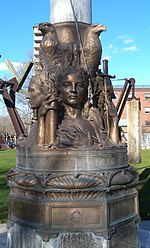
As World War I faced the nation in 1914, Pratt partnered with the United States Government to aid the war effort. The School of Science and Technology had its own Student Army Training Corps which taught enlistees engineering skills needed for the war. Students designed aircraft used in the war and trained pilots. In 1927, mechanical engineering alumnus Donald A. Hall designed the Spirit of Saint Louis, used by Charles Lindbergh in the first transatlantic flight.[21]
By 1938 most programs at the school began offering four-year Bachelor of Science degrees and Pratt transformed itself from a technical school to a rigorous college.[22] By granting bachelor's degrees, Pratt had to revise its curriculum from two years to four years. The changes also reflected New York State requirements for granting degrees and stricter government and professional licensing regulations for graduates. During this decade, the basic program for all Art School students was founded.[19] In 1940 Pratt began granting graduate degrees.[22]
During World War II Pratt also helped in the war effort as it did during World War I with the engineering school training servicemen before they were deployed. Students helped to design camouflage for soldiers, buildings, and weapons. Following the war, the school saw a large influx of veterans enrolling as part of the GI Bill.
In the 1940s, the School of Science and Technology changed its name to the School of Engineering and in 1946 established its own honor society with mechanical engineering becoming the most popular major at Pratt.[17] In 1953, Francis H. Horn became the first President of Pratt who was not a member of the Pratt family. Enrollment continued to climb throughout the decade and in 1948 the institute reached an all-time high in attendance with 6,000 students.[17] By 1950, Pratt had become accredited by the Middle States Association of Colleges and Schools.[12] In 1954, the architecture department split from the Engineering School to become its own school.[19]
Campus reorganization

As part of white flight in the 1950s and 1960s which affected the majority of New York City the neighborhood of Clinton Hill began to see a transformation from an upper-class, affluent, white community to one chiefly populated by poor and working-class people of color. Pratt considered moving its campus to more affluent Long Island or Manhattan to increase its attractiveness but decided to stay at its original Brooklyn campus due to the history and Charles Pratt's mission.[19]
As part of Robert Moses' plan for urban renewal in New York City, Pratt's physical campus saw the greatest amount of change in its history. Before the 1950s, the school was located in separate buildings located on several public streets. However, after Moses' clearance of many structures located between Pratt's buildings, including homes, the land was given over to the school, and a true campus was established. Ryerson Street, Grand Avenue, Steuben Street, and Emerson Place were closed to automobile traffic, and the campus was enclosed, forming the Grand Mall to connect the institute's buildings.[23] The elevated train running along Grand Avenue between the East Building/Student Union and the Engineering Quad was dismantled. In the new real estate, the school was able to build several new structures, all designed by the firm of McKim, Mead & White, including men's and women's dormitories and a new student union.[24] Moses' construction projects around the school helped to build the School of Architecture. Research funds were granted to the school to help discover new building techniques. By 1963, the urban planning department formed the Pratt Center for Community Development in an attempt to revitalize Pratt's surrounding neighborhood and Brooklyn.[25]
Enrollment decline and financial issues
In the 1970s and continuing well into the 1980s New York City and Brooklyn still faced large amounts of crime and poverty. Enrollment fell and the school faced a budget deficit. Prospective students and faculty felt uneasy about the safety of the campus and community. In 1974, the men's basketball team came to the attention of national media outlets when Cyndi Meserve joined the team becoming the first woman to play men's NCAA basketball.[26][27] More students earned architecture degrees than mechanical engineering degrees in 1975. Architecture degrees became the most popular degree at Pratt, and remain so.[17] In anticipation of the institute's centennial in 1987, several capital improvements were made to the campus, in an attempt to restore many dilapidated buildings. The Grand Mall was re-landscaped with new plantings, brick pathways, and lighting and the Newman Amphitheater was built in 1988 in celebration of the hundredth anniversary. President Richardson Pratt Jr retired in 1990 after nearly twenty years as president. He was the last president descended from founder Charles Pratt.
By 1993, Thomas F. Schutte was appointed as president and became the longest-serving president not from the Pratt family. In the same year, Pratt controversially closed its School of Engineering, an integral part of founder Charles Pratt's long-term vision. Historically, the school was Pratt's most successful, and many associated the school with its engineering program.[19] In response to the institute-wide decrease in enrollment and school-wide budget issues, closing the School of Engineering was thought of as being the only feasible option to keep the school's other programs afloat and to address the budget. Students in the Engineering program were transferred to Polytechnic Institute of New York University while tenured professors were relocated to the School of Architecture and the science and math departments in the School of Liberal Arts and Sciences.[28]
Revitalization and growth
By closing the costly School of Engineering, the school was able to clear its debt and get on the track to financial success. Funds were allocated for campus-wide beautification projects and restoration and modernization of historic buildings, starting with Memorial Hall. Part of the beautification projects included adding the Pratt Institute Sculpture Park in 1999 where contemporary art sculptures are placed throughout the campus lawns and gardens, making it the largest contemporary sculpture park in New York City.[29] Pratt began a partnership with Munson-Williams-Proctor and Delaware College of Art and Design for art students to study for two years at either campus and finish their degrees at Pratt's School of Art and Design in Brooklyn. During the 1990s the school was able to increase enrollment by twenty-five percent, from approximately 3,000 students in 1990 to 4,000 students in 2000.[19]
Vincent A. Stabile, a 1940 graduate of the School of Engineering, donated about $13 million to Pratt, the largest donation made by any alumnus in the college's history,[19] with the request to President Schutte that the donation be used to reopen the School of Engineering. President Schutte rejected Stabile's request and allocated his funds to construct a new residence hall named in his honor. From the mid-1980s to the 2000s Pratt experienced the transition from being mainly a commuter school to becoming a residential school through the construction of new residence halls Cannoneer Court, Pantas Hall, and Stabile Hall.
Presidents
- Charles Pratt (1830–1891), president from 1887 to 1891
- Charles Millard Pratt (1855–1935), 1891–1893
- Frederic B. Pratt (1865–1945), 1893–1937
- Charles Pratt (1892–?), 1937–1953
- Francis H. Horn 1953–1957
- Robert Fisher Oxnam (1915–1974), 1957–1960
- Richard H. Heindel 1961–1967
- James B. Donovan (1916–1970), 1968–1970
- Henry Saltzman, 1970–1972
- Richardson Pratt Jr (1923–2001) (grandson of Charles Millard Pratt and great-grandson of Charles Pratt), 1972–1990
- Warren F. Ilchman (1933–), 1990–1993
- Thomas F. Schutte (1936–), 1993–2017
- Frances Bronet, 2018–present
Academics
Rankings
Pratt Institute is currently unranked by U.S. News & World Report.[30] In its specialty rankings, U.S. News & World Report ranks Pratt 8th among "Best Fine Arts Programs" and 34th in "Best Library and Information Studies Programs".[30] The Bachelor of Architecture program has been ranked as being in the top fifteen programs in the United States consistently since 2000 according to Architectural Record.[31] Bloomberg BusinessWeek ranked the school as being one of the top 60 schools in the world to study design,[32] and respondents to a Business Insider survey said that the school was the 6th-best school for design in the world.[33]
While Kiplinger's Personal Finance previously named Pratt as one of the country's best values in private colleges and universities, it is no longer listed in their rankings.[34] It was previously included as one of the top values for academic quality and affordability out of more than 600 private institutions.
In 2023, Pratt Institute was ranked sixth globally according to the QS World University Rankings by the subject Art and Design.[35]
Schools and academic divisions
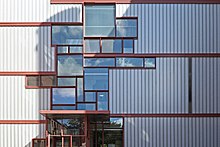
Pratt Institute is divided into 6 schools and more than 28 departments and divisions offering over 22 undergraduate majors and 25 graduate majors. The schools include:
- School of Architecture
- Department of Undergraduate Architecture
- Department of Construction Management, Facilities Management, and Real Estate Practice
- Department of Graduate Architecture and Urban Design
- Graduate Center for Planning and the Environment
- School of Art
- Department of Art and Design Education
- Department of Arts and Cultural Management
- Department of Creative Arts Therapy
- Department of Digital Arts and Animation
- Department of Design Management
- Department of Film and Video
- Department of Fine Arts
- Department of Photography
- Department of Associate Degrees
- School of Design
- Department of Undergraduate Communications Design
- Department of Graduate Communications Design
- Department of Fashion Design
- Department of Industrial Design
- Department of Interior Design
- School of Liberal Arts and Sciences
- School of Information (Pratt has the oldest continuously accredited library-science program in the United States.)
- School of Continuing and Professional Studies
Former schools
- School of Domestic Arts and Sciences
- School of Engineering
Joint degree programs
Pratt Institute offers the following joint degree programs:[36]
- J.D./Master in City and Regional Planning: Brooklyn Law School and Pratt Institute jointly sponsor a program leading to the degrees of Juris Doctor (J.D.) and Master of Science (M.S.) in City and Regional Planning.
Accreditation
Pratt Institute is accredited by the Middle States Association of Colleges and Schools and is authorized to award academic degrees by the State of New York, following guidelines established by the New York State Department of Education.[37]
The Bachelor of Architecture degree and the Master of Architecture degree at the School of Architecture are accredited by the National Architectural Accrediting Board.[38] The undergraduate Interior Design program is accredited by the Council for Interior Design Accreditation.[39]
Graduate programs in Library and Information Science, Art Therapy, and Art Education are all accredited by the Committee on Accreditation of the American Library Association, Education Approval Board of the American Art Therapy Association, and RATE respectively.[37] The School of Art and Design is one of only forty-three schools part of the Association of Independent Colleges of Art and Design.[40]
Demographics
| Undergrads | U.S. Census[42] | |
|---|---|---|
| White (non-Hispanic) | 35.4% | 60.4% |
| African-American | 3.4% | 13.4% |
| Asian American | 13.2% | 5.9% |
| Native American | 0.1% | 1.3% |
| Hispanic American (of any race) | 9.5% | 18.3% |
| Two or more races, non-Hispanic | 3.5% | 2.7% |
| International students | 34.0% | (N/A) |
| Unknown | 1.0% | (N/A) |
Pratt Institute students, numbering 3,483 undergraduates and 1,392 graduate students in Fall 2019, come from 78 countries and 47 states.[41] Women represent 71% of undergraduates and 74% of graduate students.[41]
Brooklyn campus
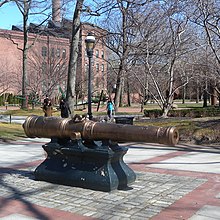
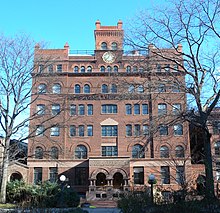
Pratt Institute's main campus is located on a historic, esteemed,[43] enclosed 25-acre (100,000 m2) campus located in the Clinton Hill neighborhood in Brooklyn, 2 miles from Downtown Brooklyn and 3 miles from Lower Manhattan. Midtown Manhattan is just 5 miles from the campus.
The campus is accessible by two public entrances, both of which close in the evening hours and are guarded by security 24 hours a day. The main gate located at Willoughby Avenue on the north side of campus is accessible for pedestrians and vehicles while the secondary pedestrian-only gate located at the corner of Hall Street and DeKalb Avenue at the southwest part of campus is convenient for commuters and for students to get to Higgins Hall. In addition, there are three other swipe card access gates available only for student use. The campus is very park-like and fully landscaped and provides a stark contrast to the urban neighborhood that surrounds the school.
The four main areas of the campus include the Library Rose Garden, Cannon Court, Newman Mall and Amphitheater, and the Engineering Quad:
- The historically significant Rose Garden is located directly north of the library and was built as a part of the library acting as a public park. At the center of the garden is a 1926 World War I memorial flagpole detailed with eagles, male, and female busts.[44]
- The Cannon Court is located directly south of the library and serves as the main entrance from the Hall Street gate. A central feature of the court is a large bronze Spanish cannon from 1720 originally from Seville, Spain, and brought to Pratt from Morro Castle in Havana, Cuba in 1899.[24] Trees and meandering pathways lead to the library and Newman Mall.
- The Newman Mall takes up the center of the campus with many of the academic buildings alongside the mall. The mall is characterized by brick pathways with mature trees lining a central lawn. To the north of the mall is a small amphitheater, designed by Skidmore, Owings and Merrill.[45]
- The Engineering Quadrangle, which is recognized as a historic landmark, is located north of the Newman Mall toward the eastern side of campus with the Chemistry, Machinery, and Engineering buildings enclosing the quad which has terraced landscaping and gardens with many mature trees.
The entire campus is open to the public as park space during the daytime. Throughout the campus, many contemporary sculptures fill the gardens and landscape, making the campus home to the largest sculpture park in New York City.[29] The sculptures are loaned to Pratt and are changed on a rotating basis. Public Art Review recognized the campus as having one of the 10 best college and university art collections in the country.[46]
List of sculptures on campus
| Displayed since | Name of sculpture | Artist |
|---|---|---|
| 2016 | La Méditerranée | Philippe Anthonioz |
| 1981 | Accord Final | Arman |
| 1999 | Picnic Table | Siah Armajani |
| 1993 | Leaf | Ilan Averbuch |
| 2005 | The Book of Stone and Steel | |
| 2011 | Maze 1 | Phyllis Baker Hammond |
| 1995 | Image 95 | Masaru Bando |
| 2014 | Whispering Bench— Texting, | Cathey Billian |
| 1995 | Wind Reeds | Bill & Mary Buchen |
| 2007 | Seven of Hearts | Noël Copeland |
| 2009 | Brooklyn Blooms | |
| 2013 | Half Story Mountain | Grayson Cox |
| 2002 | Jive | Mark di Suvero |
| 2013 | Learning | Anne Gillen |
| 1988–1993 | Leucantha, | Philip Grausman |
| 2004 | Epistrophy, Straight No Chaser, Round Midnight | Richard Heinrich |
| 2005 | Skylark | David Henderson |
| 2009 | Silo | Tomasz Jan Groza |
| 2001 | Fourth Dimension | Ann Jon |
| 2008 | Segmented Flower Form Part 1 | Mary Judge |
| 2011 | 24M | Michael Kalish |
| 2001 | Lions at the Gate | Wendy Klemperer |
| 1990–1999 | 6 Copper Spheres | Grace Knowlton |
| 2003 | Saratoga Winter | Harry E. Leigh |
| 1996 | F.R.S.B. | Donald Lipski |
| 2000 | Uplifting | Sandy Macleod |
| 1979 | Untitled | Michael Malpass |
| 1988 | Zinnia | |
| 1979 | Tool Ball | |
| 1986 | Trilogy (square) | |
| 2012 | Ascent | Jackson Martin |
| 2008–2009 | Waiting for Coyote | Nao Matsumoto |
| 1996 | Manhole Covers | Brad Michael McCallum |
| 2007 | Pratt Pillows | Mark Mennin |
| 2007 | Untitled | Sung Ha No
Zdroj:https://en.wikipedia.org?pojem=Pratt_Institute Text je dostupný za podmienok Creative Commons Attribution/Share-Alike License 3.0 Unported; prípadne za ďalších podmienok. Podrobnejšie informácie nájdete na stránke Podmienky použitia.
Analytika
Antropológia Aplikované vedy Bibliometria Dejiny vedy Encyklopédie Filozofia vedy Forenzné vedy Humanitné vedy Knižničná veda Kryogenika Kryptológia Kulturológia Literárna veda Medzidisciplinárne oblasti Metódy kvantitatívnej analýzy Metavedy Metodika Text je dostupný za podmienok Creative
Commons Attribution/Share-Alike License 3.0 Unported; prípadne za ďalších
podmienok. www.astronomia.sk | www.biologia.sk | www.botanika.sk | www.dejiny.sk | www.economy.sk | www.elektrotechnika.sk | www.estetika.sk | www.farmakologia.sk | www.filozofia.sk | Fyzika | www.futurologia.sk | www.genetika.sk | www.chemia.sk | www.lingvistika.sk | www.politologia.sk | www.psychologia.sk | www.sexuologia.sk | www.sociologia.sk | www.veda.sk I www.zoologia.sk |

